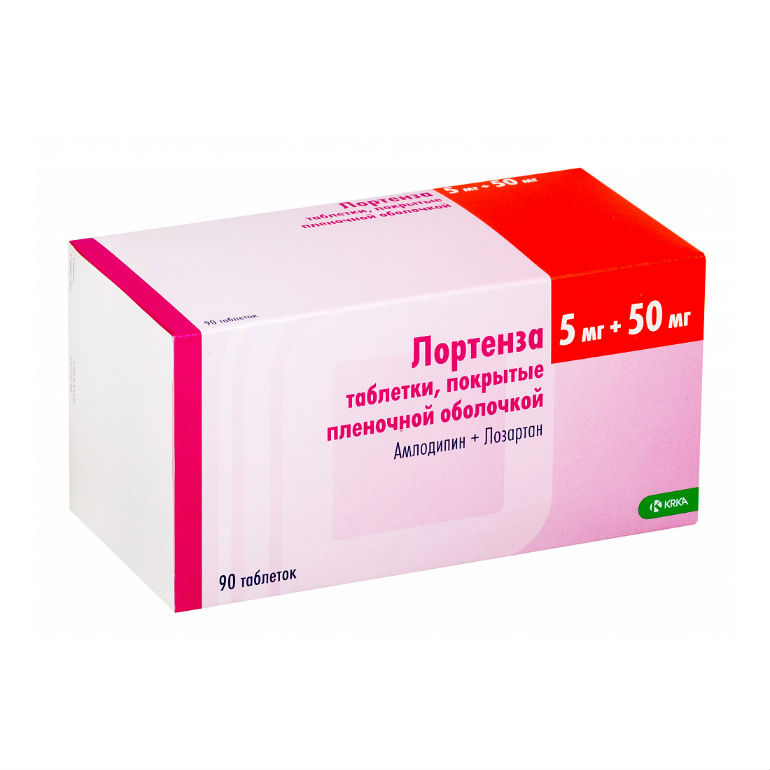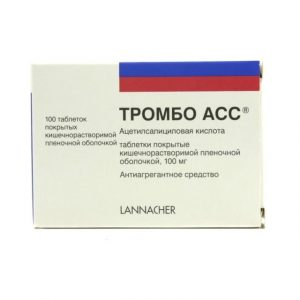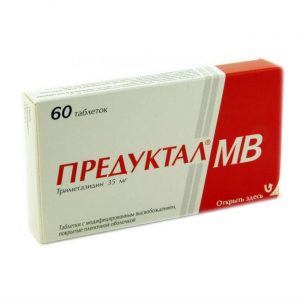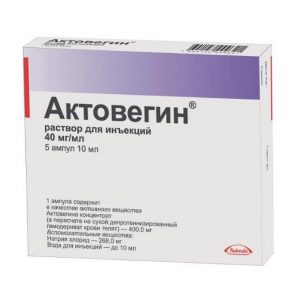Description
Pharmacological action
Combined antihypertensive drug containing active ingredients with complementary hypotensive effect: amlodipine (calcium channel blockers) and losartan (angiotensin II receptor antagonist). The active components of the drug have a different mechanism of antihypertensive action: amlodipine – due to vasodilation reduces OPSS, losartan – due to exposure to RAAS inhibits the effects of angiotensin II, which leads to a more pronounced decrease in blood pressure compared with that of monotherapy with each drug.
Amlodipine is a calcium channel blocker, a derivative of dihydropyridine. It has antianginal and hypotensive effects. Amlodipine inhibits the transmembrane transition of calcium ions to cardiomyocytes and smooth muscle cells of the vascular wall. The antihypertensive effect of amlodipine is due to a direct relaxing effect on smooth muscle cells of the vascular wall. The mechanism of antianginal action of amlodipine is not fully understood, presumably, it is associated with the following effects: it causes the expansion of peripheral arterioles, decreasing OPSS – afterload, which leads to a decrease in the oxygen demand of the myocardium and causes the expansion of the coronary arteries and arterioles in both intact and ischemic areas of the myocardium, which increases the flow of oxygen into the myocardium, including in patients with Prinzmetal angina. Amlodipine reduces the severity of left ventricular hypertrophy. It does not affect myocardial contractility and conductivity, does not cause a reflex increase in heart rate, inhibits platelet aggregation, increases GFR, and has a weak natriuretic effect.
In patients with arterial hypertension, taking amlodipine 1 time / day provides a clinically significant decrease in blood pressure (lying and standing) for 24 hours. The antihypertensive effect develops slowly, and therefore the development of acute arterial hypotension is uncharacteristic. In patients with angina pectoris, taking amlodipine 1 time / day increases exercise tolerance, the time before the development of an attack of angina pectoris and to ischemic depression of the ST segment, reduces the frequency of angina attacks and the need for taking nitroglycerin (short-acting forms). Amlodipine does not have an undesirable effect on lipid metabolism and does not cause changes in the lipid profile of blood plasma. Amlodipine can be used in patients with bronchial asthma, diabetes mellitus and gout.
With a single oral administration, the effect of amlodipine begins after 2-4 hours and lasts for 24 hours. The maximum hypotensive effect is achieved no earlier than 4 weeks from the start of the drug. The hemodynamic effects of the drug remain unchanged with long-term use.
Losartan is an angiotensin II receptor antagonist (type AT1) for oral administration. Angiotensin II, a powerful vasoconstrictor, is the main hormone of RAAS and an important determining factor in the pathophysiology of arterial hypertension. Angiotensin II binds to AT1 receptors found in many body tissues (vascular smooth muscle, adrenal glands, kidneys and heart) and mediates important effects such as vasoconstriction and aldosterone release. Angiotensin II also stimulates the proliferation of vascular smooth muscle cells. Losartan selectively blocks AT1 receptors. Both in vitro and in vivo losartan and its pharmacologically active carboxylated metabolite E-3174 block all physiologically related effects of angiotensin II, regardless of the source or route of its synthesis in the body.
Losartan does not have an agonistic effect and does not block the receptors of other hormones or ion channels involved in the regulation of cardiovascular activity. In addition, losartan does not inhibit ACE, which breaks down bradykinin. Accordingly, when taking losartan, potentiation of bradykinin-mediated adverse effects is not observed.
When taking losartan, eliminating the negative feedback of angiotensin II and renin secretion leads to an increase in plasma renin activity, which, in turn, increases the concentration of angiotensin in blood plasma. Despite these changes, the hypotensive effect and a decrease in the concentration of aldosterone in the blood plasma persist, indicating an effective blockade of AT1 receptors. 3 days after stopping losartan, plasma renin activity and angiotensin concentration in blood plasma are reduced to baseline values.
Indications
arterial hypertension in patients who are shown combination therapy with amlodipine and losartan.
Special instructions
In patients with reduced BCC (for example, when taking diuretics in high doses, severe diarrhea, vomiting and other conditions leading to hypovolemia), symptomatic arterial hypotension may develop at the beginning of drug therapy. Before using this combination, the deficiency of bcc should be eliminated. For patients in which the daily dose of losartan is 25 mg, the use of this combination is not recommended.
Due to the prolonged T1 / 2 of amlodipine, vasodilation, which developed as a result of taking the drug, can persist even after its withdrawal. Thus, the use of another vasodilator after the cancellation of amlodipine should be carried out with caution, an individual assessment of the dose, dosage interval and active monitoring of the patient’s condition are necessary.
During the treatment period, it is necessary to control body weight and consumption of sodium chloride, the appointment of an appropriate diet. It is necessary to maintain dental hygiene and frequent visits to the dentist (to prevent soreness, bleeding and gingival hyperplasia).
Hyperkalemia (potassium in the blood plasma> 5.5 mmol / L) was observed in 1.5% of patients taking losartan as monotherapy. None of these cases required drug withdrawal. The simultaneous use of potassium-sparing diuretics (for example, spironolactone, triamteren, amiloride, eplerenone), potassium preparations, potassium-containing salt substitutes, as well as drugs that can lead to an increase in the potassium content in blood plasma (for example, heparin), with losartan should be justified ( especially in elderly patients with impaired renal function), and the potassium content in blood plasma should be regularly monitored.
Taking losartan can lead to transient arterial hypotension, accompanied by shock, fainting, and shortness of breath.
In patients with a history of angioedema (swelling of the larynx, vocal cords, face, lips, pharynx and / or tongue), control of the drug is necessary.
As with other drugs, having an effect on RAAS, in patients with chronic heart failure with or without impaired renal function, there is a risk of severe arterial hypotension or acute renal impairment.
there is insufficient experience with the use of losartan in patients with chronic heart failure and concomitant severe renal impairment, in patients with severe heart failure (IV FC according to NYHA classification), as well as in patients with heart failure and symptomatic life-threatening arrhythmias, the drug should be used with caution .
Like all drugs with a vasodilating effect, angiotensin II receptor antagonists should be used with caution in patients with coronary artery disease or cerebrovascular disease, since an excessive decrease in blood pressure in this group of patients can lead to the development of myocardial infarction or stroke.
in patients with primary hyperaldosteronism, as a rule, a positive response to therapy with antihypertensive drugs that act by inhibiting RAAS is not observed, the use of this combination is not recommended.
Pharmacokinetic studies indicate that patients with cirrhosis have a significant increase in plasma losartan concentrations. The use of the drug is not recommended in patients with severe liver failure (more than 9 points on the Child-Pugh scale), as well as in patients with liver failure (less than 9 points on the Child-Pugh scale), who are recommended to reduce the dose of losartan to 25 mg / day.
Due to inhibition of RAAS in some predisposed patients taking losartan, changes in renal function were reversible when the drug was canceled.
In patients whose renal function may depend on RAAS activity (for example, with chronic heart failure III-IV FC according to NYHA classification), the use of ACE inhibitors was accompanied by oliguria and / or increasing azotemia and, rarely, acute renal failure and / or death . A similar pattern was observed with the use of losartan in such patients.
In clinical studies, the use of ACE inhibitors in patients with unilateral or bilateral renal artery stenosis led to an increase in the concentration of creatinine and residual urea nitrogen in the blood plasma. A similar effect was observed with losartan in this group of patients, but was reversible upon discontinuation of the drug, so this combination should be taken with caution.
Influence on the ability to drive vehicles and control mechanisms
Caution should be exercised when driving vehicles and working with other technical devices that require increased concentration of attention and speed of psychomotor reactions, taking into account the risk of dizziness.
Composition
1 tab. contains: Active substances: amlodipine 5 mg losartan potassium 50 mg.
Excipients: cellulose 80 36.45 mg, microcrystalline cellulose 212.96 mg, pregelatinized starch 54.00 mg, sodium carboxymethyl starch 22.00 mg, yellow dye oxide (E172) 0.40 mg, colloidal silicon dioxide 1.6 mg, 5.1 mg magnesium stearate.
Shell composition: Opadry II white 25.71 mg, yellow iron oxide dye – 1.03 mg, red iron oxide dye – 0.26 mg.
Dosage and administration
The drug is taken orally 1 time / day, regardless of the time of meal, with a small amount of water.
The dose is selected after previously titrated doses of the individual components of the drug. If a change in the dose of one of the active substances in a fixed combination preparation is required (for example, in connection with a newly diagnosed disease, a change in the patient’s condition or drug interaction), an individual selection of doses of the individual components is necessary.
Patients taking losartan and amlodipine at the same time can be transferred to a combination drug containing losartan and amlodipine in the same doses.
The recommended dose of the drug is 1 tablet / day.
The drug in a dose of 5 mg + 50 mg is prescribed to patients who did not achieve adequate blood pressure control when using amlodipine at a dose of 5 mg or losartan at a dose of 50 mg in monotherapy.
The drug at a dose of 5 mg + 100 mg is prescribed to patients who have not achieved adequate control of blood pressure when using losartan at a dose of 100 mg or a combination drug at a dose of 5 mg + 50 mg.
The drug at a dose of 10 mg + 50 mg is prescribed to patients who have not achieved adequate control of blood pressure when using amlodipine at a dose of 10 mg or a combination drug at a dose of 5 mg + 50 mg.
The drug at a dose of 10 mg + 100 mg is prescribed to patients who have not achieved adequate control of blood pressure when using the combined drug at a dose of 5 mg + 100 mg or 10 mg + 50 mg.
The maximum daily dose is 10 mg + 100 mg.
In patients with renal failure with CC from 50 to 20 ml / min, dose adjustment is not required. The drug is contraindicated in patients with CC <20 ml / min and in patients undergoing hemodialysis. The use of this combination is possible in patients with impaired liver function (less than 9 points on the Child-Pugh scale), who, according to a doctor’s decision, recommended the use of losartan in a dose of 50 mg. In elderly patients, dose adjustment of the drug is not required, but the dose should be increased carefully. The drug should not be prescribed to children and adolescents under the age of 18 years, because there are no data on the efficacy and safety of use in this group of patients. In patients with reduced BCC (for example, due to treatment with high doses of diuretics), the initial dose of losartan should be reduced to 25 mg 1 time / day. Due to the lack of a given dosage combination containing 25 mg of losartan, this dose should be prescribed in losartan monotherapy. Before using the drug, it is necessary to restore the BCC and the sodium content in the blood plasma. Side effects Determination of the frequency of adverse reactions according to WHO: very often ( 1/10), often ( 1/100 to <1/10), infrequently ( 1/1000 to <1/100) , rarely (from 1/10 000 to <1/1000), very rarely (<1/10 000), the frequency is unknown (cannot be estimated based on available data). From the side of the nervous system: often – dizziness, headache infrequently – drowsiness. From the digestive system: infrequently – constipation, discomfort in the abdomen, dyspepsia, vomiting, esophageal reflux. From the skin and subcutaneous tissue: infrequently – itchy skin. Allergic reactions: infrequently – urticaria. From the cardiovascular system: infrequently – palpitations, flushing of the face, orthostatic hypotension. From the respiratory system: infrequently – shortness of breath. From the side of the organ of hearing and balance: infrequently – systemic dizziness. From the urinary system: infrequently – increased frequency of urination. General disorders: infrequently – asthenia, discomfort or pain in the chest, a feeling of fullness in the abdomen, peripheral edema. Side effects observed when taking the drug components (amlodipine and losartan), may also be potential side effects when using a combination drug. Amlodipine From the hemopoietic system: very rarely – thrombocytopenic purpura, leukopenia, thrombocytopenia. From the side of metabolism: very rarely – hyperglycemia. From the nervous system: often – headache (especially at the beginning of treatment), dizziness, increased fatigue, drowsiness infrequently – hyperesthesia, paresthesia, peripheral neuropathy, tremor, increased irritability very rarely – migraine, ataxia, amnesia. From the psyche: infrequently – insomnia, unusual dreams, lability of mood (including anxiety), depression rarely – confusion very rarely – apathy, agitation. From the side of the organ of vision: infrequently – diplopia, impaired accommodation, xerophthalmia, conjunctivitis, pain in the eyes. From the side of the organ of hearing and balance: infrequently – ringing in the ears. From the cardiovascular system: often – palpitations, inflow of blood to the skin of the face infrequently – excessive decrease in blood pressure is very rare – fainting, shortness of breath, vasculitis, orthostatic hypotension, development or worsening of the course of chronic heart failure, heart rhythm disturbance (including bradycardia, ventricular tachycardia and atrial fibrillation), myocardial infarction. From the respiratory system: infrequently – shortness of breath, rhinitis, nosebleeds very rarely – cough, pulmonary edema. From the digestive system: often – nausea, rarely abdominal pain – vomiting, constipation or diarrhea, flatulence, dyspepsia, anorexia, dry mouth, thirst rarely – gum hyperplasia, increased appetite very rarely – pancreatitis, gastritis, jaundice (due to cholestasis), hyperbilirubinemia, increased activity of hepatic transaminases, hepatitis. From the urinary system: infrequently – rapid urination, painful urination, nocturia is very rare – dysuria, polyuria. From the genitals and mammary gland: infrequently – gynecomastia, impotence. From the musculoskeletal system: infrequently – muscle cramps, myalgia, arthralgia, arthrosis rarely – myasthenia gravis. From the skin and subcutaneous tissue: rarely – exfoliative dermatitis, Stevens-Johnson syndrome very rarely – itching, rash (including erythematous, maculopapular rash), alopecia, xeroderma, increased sweating, cold sweat, pigmentation disorders skin, erythema multiforme, photosensitivity reactions. Allergic reactions: very rarely – urticaria, Quincke’s edema. Other: infrequently – general malaise, weight loss, weight gain, back pain is very rare – asthenia, parosmia, chest pain, swelling of the lower extremities. losartan From the hematopoietic system: infrequently – anemia rarely – thrombocytopenia. From the side of metabolism: infrequently – gout. From the nervous system: often – dizziness, headache infrequently – cerebrovascular accident, drowsiness, memory impairment, peripheral neuropathy, paresthesia, hyperesthesia, tremor, ataxia, systemic dizziness, memory impairment, migraine, nervousness. Mental disorders: often – insomnia infrequently – sleep disturbances, anxiety, anxiety disorder, confusion, depression, unusual dreams, panic disorder. From the side of the organ of vision: infrequently – blurred vision, burning sensation / injection in the eye, conjunctivitis, decreased visual acuity. From the side of the organ of hearing and balance: infrequently – ringing in the ears. From the cardiovascular system: infrequently – myocardial infarction, angina pectoris, cardiac arrhythmias (atrial fibrillation, sinus bradycardia, tachycardia, ventricular tachycardia, ventricular fibrillation), palpitations, orthostatic hypotension, syncope, arterial hypertension. From the respiratory system: often – shortness of breath, bronchitis, dry cough, discomfort in the throat, nosebleeds, rhinitis, laryngitis. From the digestive system: often – nausea, diarrhea, dyspepsia, abdominal pain infrequently – anorexia, taste disorder, constipation, toothache, dry mouth, flatulence, gastritis, hepatitis, impaired liver function, pancreatitis. From the urinary system: infrequently – a violation of the frequency of urination, nocturia, infection of the urinary tract is very rare – renal failure. From the genitals and mammary gland: infrequently – decreased libido, impotence. From the musculoskeletal system: often – cramps, musculoskeletal pain, swelling of the joints, joint stiffness infrequently – arthralgia, arthritis, fibromyalgia rarely – rhabdomyolysis. On the part of the skin and subcutaneous tissue: infrequently – alopecia, dry skin, skin rash, reddening of the skin, Shenlein-Genokha purpura, photosensitivity, pruritus, increased sweating. Allergic reactions: infrequently – urticaria, angioedema. General disorders: often – asthenia, fatigue, weakness, chest pain, swelling of the face, fever, asthenia, increased weakness, frequency is unknown – flu-like symptoms. Active ingredient Amlodipine, losartan Terms of delivery from pharmacies Prescription dosage form tablets




